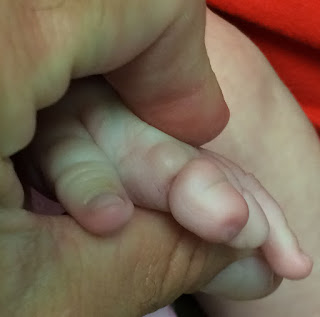Amniotic Constriction Band is a common problem in our clinics. Kids can have a diagnosis of amniotic constriction band and yet their hands can all look very different from one another as there are simply so many different presentations. I have previously written about this topic here but I wanted to share a few more thoughts.
We typically think of 3 things when we make a diagnosis of amniotic constriction band. Kids may have 1, 2, or 3 of these issues- that is what makes the diagnosis so different from one child to the next. First, they can have constriction rings or indentations in the skin. These can be mild or can go really deep. If deep enough, the blood supply to the finger (or for that matter the whole arm if the ring is higher up in the arm) can be affected and can theoretically not survive. These rings can be in the arms, hands, or legs.
The next issue is amputation, or loss of an arm or more commonly a finger or part of a finger. We think this is related to a deep, tight ring while the baby is still in the womb. Rarely, a newborn can have a tight ring and we worry that the finger might not live unless we do surgery to save it (and that is what happened in this child’s thumb- early surgery may have saved the thumb).
The final issue is amniotic constriction band is joining of the fingers together- the so- called syndactyly. This is different from other types of syndactyly as we believe it is related to scarring after an amputation of a finger. It can be two fingers or the whole hand. This can be difficult to treat but early treatment can lead to really satisfying results and a great hand.
Here is a case for consideration showing all 3 types of problems in amniotic constriction band.
First is the left hand. Note the constriction in the index finger. This can be addressed with surgery which will decrease the band and allow more normal growth. The second picture has a side view showing another view of the band. The rest of this hand looks pretty good. The middle finger (or long finger) has been amputated and is about the length of the index finger. Amputation of the long finger is most common.
 |
| Amniotic constriction band with a tight band of the index finger. |
 |
| Amniotic constriction band with a tight band of the index finger, a side view. |
The right hand is more complicated in this case of amniotic constriction band. The thumb had urgent surgery after birth for a tight band and looks very good now. There is also a reasonably well formed pinky. The ring finger has a tight band that will be released. But the other digits are joined together from scarring and are short due to amputations. Early surgery may help create better, more functional fingers and hand.
 |
| Amniotic constriction band with a thumb band previously released. |
 |
| Amniotic constriction band with a tight ring finger band, amputations of other digits. |
 |
| Amniotic constriction band with several amputations. |
 |
| Amniotic constriction band with a tight band of the ring finger. |
Charles A. Goldfarb, MD
My Bio at Washington University
congenitalhand@wudosis.wustl.edu